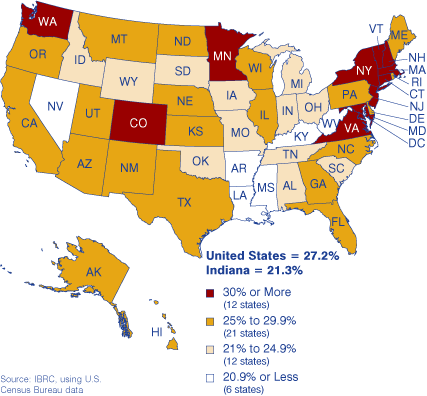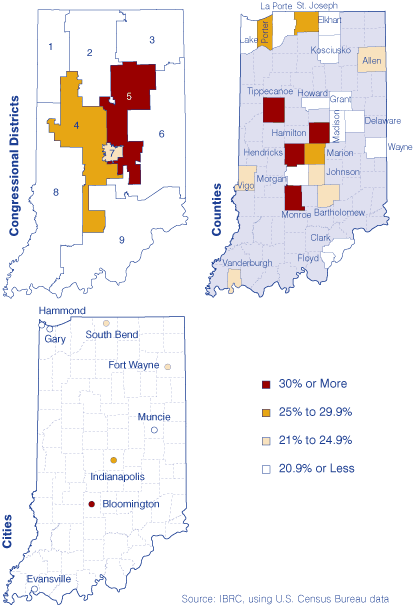How Educated Are We?
Nationwide, 27.2 percent of adults have a bachelor's degree or higher. Meanwhile, only 21.3 percent of Hoosiers age 25 and older have accomplished that feat according to the 2005 American Community Survey (ACS) household-based estimates.
While the state has seen some improvement in its percentage,
Indiana still ranked 45th in the nation, a position that has not fluctuated
much in recent years. The six states ranking below Indiana in 2005 include
Louisiana (20.6 percent), Nevada (20.6 percent), Kentucky (19.3 percent),
Arkansas (18.9 percent), Mississippi (18.7 percent) and West Virginia
(16.9 percent).
At the other end of the spectrum, more than 35 percent of the adult population in the District of Columbia (45.3 percent), Massachusetts (36.9 percent) and Colorado (35.5 percent) have attained a bachelor's degree or higher (see Figure 1).
Figure 1: Percent of Population 25 or Older with a Bachelor's Degree or Higher, 2005

Since one of the primary benefits of this new ACS release is the expanded geographic coverage, Figure 2 shows the same data for all Indiana's congressional districts, as well as counties and cities with at least 65,000 people.
Figure 2: Percent of Population 25 or Older with a Bachelor's Degree or Higher by Indiana Divisions, 2005

For congressional districts, the percent with a bachelor's degree ranged from 16.9 percent in District 6 to 34.1 percent in District 5. At the county level, Hamilton County far surpassed the others with a high of 53.6 percent. Grant County had the lowest percentage among the 24 counties with just 13.1 percent of its adults holding a bachelor's or more. Among the eight cities with data available, Bloomington exceled with 53.7 percent of its population having a bachelor's or more (not surprising since it is home to Indiana University). Hammond and Gary fell at the other end of the gamut, at 9.6 percent and 11.5 percent, respectively.
Notes
- The American Community Survey estimates are for individuals living in households, thus excluding people in group quarters (such as dormitories and prisons).
- The 2002 figure was 20.6 percent with a margin of error of 2.3 percentage points. The 2005 figure was 21.3 percent with a margin of error of 0.4 percentage points.
Rachel Justis, Managing Editor
Indiana
Business Research Center, Kelley School of Business, Indiana University
